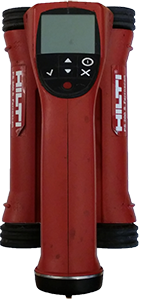We have encountered some confusion when potential clients send requests for “Ferroscanning” and to help clear up the confusion; we […]
We have encountered some confusion when potential clients send requests for “Ferroscanning” and to help clear up the confusion; we would like to take this opportunity to explain scanning in general.

Hilti Ferro Scanner PS200
Ferroscanning is ONE type of scanning: when we use a ‘Ferroscanner’ (e.g. Hilti PS200) it picks up ferrous (iron) material in structures and returns a signal. This piece of equipment only returns a signal from the ferrous material and has a limited depth range; generally, it can only be relied upon to accurately pick up a single layer of steel. It is, however, very accurate in what it offers at this range and is very sensitive to ferrous material. This is usually an advantage but does make it impossible to accurately scan structures like block work, as the sand used to make blocks is full of iron (this causes the signal to be scrambled).
Ground Penetrating Radar (GPR) is ANOTHER type of scanning that we often use and is part of our ‘scanning suite’: GPR uses an object to reflect off, whether ferrous or non-ferrous (e.g. aluminum, metal, plastic etc.). GPR has a better depth range than the Ferroscanner, however, as we move deeper through a structure, accuracy is compromised. The GPR will also pick up voids as the signal changes with the change in density of the structure we are scanning. Of course, it is only GPR that we can use for block scanning as the ferrous material in the sand does not scramble the signal.
At CSI we have also used the GSSI scanners and smaller cover meters when the need arises.
Other than block work, we will often use the scanners in tandem to give us a very clear picture of what is contained in the structure. It is a very rare occasion when we would use only one scanner. Using the capabilities of both devices gives us a much clearer picture of what is inside any given structure. This is an important factor to consider when pricing jobs as well, because, as with all pricing, it is important to ‘compare apples with apples’!
If you’d like to talk to New Zealand’s scanning experts then CSI can assist you with independent, accurate and nondestructive scanning services. Drop us a line directly via email or phone 0800 33 7767.
Comments are closed.
I love what you said about using scanners in order to get a clear picture of what lies within a concrete structure. Concrete scanning seems like a good practice when it comes to analyzing a structure’s schematics and components. If I were to operate on a construction site, I would spend some time locating a concrete scanning service that can inspect any existing structures.
Regards for this post, I am a big fan of this site would like to go
along updated.
The difference shared between ferroscanning, and ground-penetrating radar is remarkable. I appreciate your work!